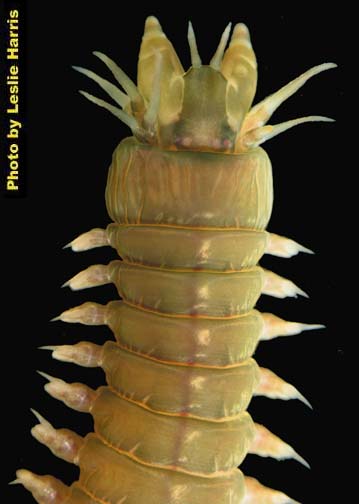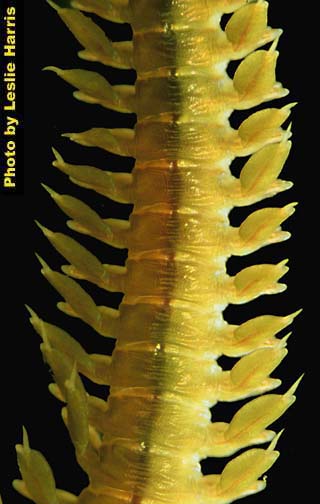California Academy of Sciences
Home What is a Settling Plate? Settling Plate Organisms Participating Schools Get Involved!
Nereis vexillosa Grube, 1851 - Native
Nereis vexillosa is a pileworm that is native to San Francisco Bay, and ranges along the northern pacific coast from Alaska to San Diego (Ricketts, Calvin, and Hedgpeth 1968). This active nereid is a relatively large species; adults can attain lengths of up to 30 cm, although specimens this large are not typically found in the Bay. Their color is usually an iridescent green to brown. N. vexillosa is relatively polyhaline in its range, occurring in areas of the Bay that consistently experience high levels of salinity. On average, this species is found closer to the Golden Gate than the euryhaline Neanthes succinea (see photos for this species). N. vexillosa can be found in a wide variety of habitats from subtidal gravel or rocky intertidal mussel beds of the outer coast, to dock fouling and subtidal habitats of sheltered bays.
The types of bristles (setae) found in the dorsal sections (notopodia) of their posterior parapodia can distinguish these two species from one another. Additionally, live specimens tend to carry their dorsal cirri (dorsal extensions of the notopodia) more distally on their strap-like posterior notopodia in N. vexillosa than in N. succinea (see photographs of the posterior regions of each species).
Nereis vexillosa is an active predator, and is equipped with a set of fierce-looking jaws on the tip of its proboscis which it can "shoot out" to prey upon soft-bodied animals. This species is used commonly as a bait animal for fishermen.
During reproduction, both sexes transform their entire bodies into epitokes a process called epigamy. Nereid epitokes are modified and more active reproductive forms called heteronereids, which are completely filled with gametes... their sole purpose being reproduction. These heteronereids grow long, modified swimming setae and large eyes for better sensory and mobility. Sexes in these stages swarm together, following the release of pheromones stimulated by the lunar cycle. Reproductive males leave their burrows at night and swims rapidly around, shedding their sperm. This process stimulates reproductive females in the area to follow, releasing their eggs and allowing fertilization to occur. Release of gametes involves the rupture of body walls, most times resulting in the death of the worm. This species is considered to be semelparous, breeding once in their lifetime.
 |
 |


